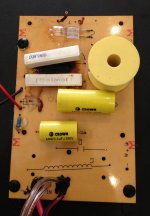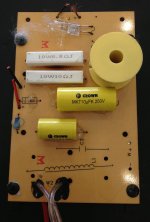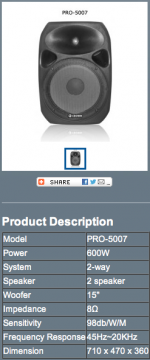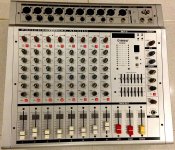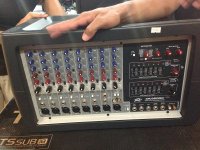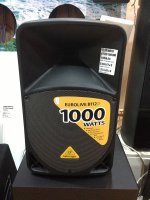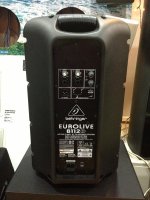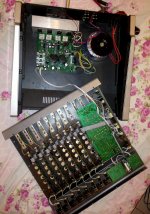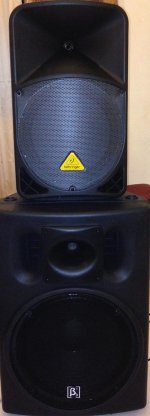Hello all, I sure hope someone here can help me out.
Unfortunately I am a bit of a newb at this, I recently got a set of Crown speakers for my new restaurant, we have accoustic bands playing every weekend, but I am having difficulties with them always burning these things (photo's attached) and then the horns no longer work.
I have had them repaired twice already but the problem persists and I wondered if anybody with some technical experience would be able to shed some light on this issue for me.
I'm not sure if these are capacitors or resistors, like I said I am new to this but am very handy with a soldering iron, I was thinking that these things may be the wrong size (10W 6.8 Ohms) (don't know what the "J" means after the Ohms sign) and was hoping that someone could suggest what other sizes I might try in order to eliminate this issue, I'm guessing the complete circuit board is a crossover system, but it's not working too good!
I'm sorry I don't know all the specs of the horns in these speaker cabs, I only got the data sheet from the net (photo attached).
The speakers are never driven too loud, we only have 3 mics and 3 acoustic guitars usually going through them via a 300/300 powered mixer in a relatively small restaurant.
Thanks so much for any help/suggestions, I know they are pretty cheap speakers & I don't have all the data you might need, but they sound not too bad and are ample for my needs.
Please note that the horn/tweeter itself does not fail, it's the components on the board that overheats and one end keeps disconnecting itself (burning, see photo 1) what would be causing this overheating?
Regards to all,
Ian.
Unfortunately I am a bit of a newb at this, I recently got a set of Crown speakers for my new restaurant, we have accoustic bands playing every weekend, but I am having difficulties with them always burning these things (photo's attached) and then the horns no longer work.
I have had them repaired twice already but the problem persists and I wondered if anybody with some technical experience would be able to shed some light on this issue for me.
I'm not sure if these are capacitors or resistors, like I said I am new to this but am very handy with a soldering iron, I was thinking that these things may be the wrong size (10W 6.8 Ohms) (don't know what the "J" means after the Ohms sign) and was hoping that someone could suggest what other sizes I might try in order to eliminate this issue, I'm guessing the complete circuit board is a crossover system, but it's not working too good!
I'm sorry I don't know all the specs of the horns in these speaker cabs, I only got the data sheet from the net (photo attached).
The speakers are never driven too loud, we only have 3 mics and 3 acoustic guitars usually going through them via a 300/300 powered mixer in a relatively small restaurant.
Thanks so much for any help/suggestions, I know they are pretty cheap speakers & I don't have all the data you might need, but they sound not too bad and are ample for my needs.
Please note that the horn/tweeter itself does not fail, it's the components on the board that overheats and one end keeps disconnecting itself (burning, see photo 1) what would be causing this overheating?
Regards to all,
Ian.
Attachments
Last edited:
The fact that you keep burning components indicates these are not ample for your needs.
A circuit diagram of the crossover board would be very useful, but so far as I can see, those resistors could only serve a couple of purposes:
1 - tweeter attenuation
2 - woofer zobel
Play some music, and measure the voltage across them. Preferably with an oscilloscope.
Either way, though, if you do up-rate the resistors so they don't burn out, something else further down may well die as a result.
Chris
A circuit diagram of the crossover board would be very useful, but so far as I can see, those resistors could only serve a couple of purposes:
1 - tweeter attenuation
2 - woofer zobel
Play some music, and measure the voltage across them. Preferably with an oscilloscope.
Either way, though, if you do up-rate the resistors so they don't burn out, something else further down may well die as a result.
Chris
Well, you are clearly overdriving them , and they fail.
And increasing resistor size won't help much, since you won't solve the main problem.
You might also have an unexperienced sound operator or even no operator at all, just roughly set up levels and leave Musicians on their own..
Can't help with the last problem, only experience will, but as far as your speaker problems, I strongly suggest you buy a couple powered cabinets and for now use your 300+300W powered mixer as a mixer alone.
*Looks* redundant, I know, but integrated powered cabinets already have "expertise" built in, meaning *perfectly matched* speakers and amplifiers, proper crossovers (active, by the way) and most important, custom set internal limiters, so no amp clips and no speaker dies.
Worst case, you drive them too much and they stop getting louder, no big deal.
Solve your problem now, as in next Thursday you may have a good sounding, safe system in use, and concentrate on your main cash earning Business: selling food, wine, etc.
In the future, you can use those (repaired) Crown cabinets at quite lower power, as stage monitors for the Musicians, or, say, help at the end of the room or fill, say, an "L" shaped room weak side or similar auxiliary uses.
But first make certain your *main* PA is solid and safe.

And increasing resistor size won't help much, since you won't solve the main problem.
You might also have an unexperienced sound operator or even no operator at all, just roughly set up levels and leave Musicians on their own..
Can't help with the last problem, only experience will, but as far as your speaker problems, I strongly suggest you buy a couple powered cabinets and for now use your 300+300W powered mixer as a mixer alone.
*Looks* redundant, I know, but integrated powered cabinets already have "expertise" built in, meaning *perfectly matched* speakers and amplifiers, proper crossovers (active, by the way) and most important, custom set internal limiters, so no amp clips and no speaker dies.
Worst case, you drive them too much and they stop getting louder, no big deal.
Solve your problem now, as in next Thursday you may have a good sounding, safe system in use, and concentrate on your main cash earning Business: selling food, wine, etc.
In the future, you can use those (repaired) Crown cabinets at quite lower power, as stage monitors for the Musicians, or, say, help at the end of the room or fill, say, an "L" shaped room weak side or similar auxiliary uses.
But first make certain your *main* PA is solid and safe.
You should be glad Crown is using resistors are fuses instead of letting your signal blow up the expensive drivers. Do not increase the fuse wattage.
You could ut some of these ahead of all components to take excessive surge: V82ZA12P - LITTELFUSE - METAL OXIDE VARISTOR, 68V, 145V RAD | Newark element14 US
They trip at 68 v and suck excess current. 69 V is 600 W into 8 ohms. But this would transfer your problem into the mixer/amp.
Really you need to control the signal getting to the speakers. A stack of 1 watt Zeners equaling 60 v rating, followed by an led, between your speaker hot and ground, would tell you the DJ is doing something dangerous. The led would blink when the signal is too hot.
As far as the waveform shape, Peavey has done something about that in their pro PA amps. They have something called "DDT" that measures when the signal is the wrong shape for speakers, and squeezed the signal down when it is. I proscribe a CS800s or CS800x amp with the "DDT" turned on at all times. That is less than 400 W per speaker, which should be safe anyway. Unless the DJ crams the amp feed signal up where it clips all the time. These speakers should fill a small bar adequately, IMHO.
The gain on the power amp should be locked where the DJ can't fool with it, and the DDT left on. This is such a problem with PA, they sell "limiters" which are boxes that control the signal going into the power amp to keep the DJ or musician from destroying stuff. This should be also set up under lock and key. that way if the musicians cram the signal too high, it just sounds bad, it doesn't destroy your PA system. The limiter has its own leds. So you set up the system to limit at the capability of your PA system, blink the red light when doing so where the musicians can see it, and let the musicians control only the power on switch to the house PA.
Good luck.
You could ut some of these ahead of all components to take excessive surge: V82ZA12P - LITTELFUSE - METAL OXIDE VARISTOR, 68V, 145V RAD | Newark element14 US
They trip at 68 v and suck excess current. 69 V is 600 W into 8 ohms. But this would transfer your problem into the mixer/amp.
Really you need to control the signal getting to the speakers. A stack of 1 watt Zeners equaling 60 v rating, followed by an led, between your speaker hot and ground, would tell you the DJ is doing something dangerous. The led would blink when the signal is too hot.
As far as the waveform shape, Peavey has done something about that in their pro PA amps. They have something called "DDT" that measures when the signal is the wrong shape for speakers, and squeezed the signal down when it is. I proscribe a CS800s or CS800x amp with the "DDT" turned on at all times. That is less than 400 W per speaker, which should be safe anyway. Unless the DJ crams the amp feed signal up where it clips all the time. These speakers should fill a small bar adequately, IMHO.
The gain on the power amp should be locked where the DJ can't fool with it, and the DDT left on. This is such a problem with PA, they sell "limiters" which are boxes that control the signal going into the power amp to keep the DJ or musician from destroying stuff. This should be also set up under lock and key. that way if the musicians cram the signal too high, it just sounds bad, it doesn't destroy your PA system. The limiter has its own leds. So you set up the system to limit at the capability of your PA system, blink the red light when doing so where the musicians can see it, and let the musicians control only the power on switch to the house PA.
Good luck.
Hi all & thank you so much for your reply's, the speakers do have a blue LED on the front and it is almost constantly lit, so I guess they are being driven too much but don't sound too loud at all! (dodgy/misleading rating maybe).
I am going to put these speakers back in my home for my wife's karaoke & buy a decent set-up for the live music venue.
I am from Scotland, played in bands all my life, now I'm 50 & have lived in the Philippines for the last 10 years, this could explain the inferior equipment as many copies are made here so you are never really sure you get the genuine item!
I came to the closest major city (7hr bout ride) today with the intension of purchasing a set of powered monitors, but looks like I will be looking for a complete new PA system now!
Thanks again to all for your helpful advise.
Ian.
I am going to put these speakers back in my home for my wife's karaoke & buy a decent set-up for the live music venue.
I am from Scotland, played in bands all my life, now I'm 50 & have lived in the Philippines for the last 10 years, this could explain the inferior equipment as many copies are made here so you are never really sure you get the genuine item!
I came to the closest major city (7hr bout ride) today with the intension of purchasing a set of powered monitors, but looks like I will be looking for a complete new PA system now!
Thanks again to all for your helpful advise.
Ian.
Counterfeits is a problem all over the orient. I've got a pair of Peavey SP2XT speakers (8 ohm) which are similar design to the Crown prototype. I have a CS800s amp that, when it is not tripping the breaker due to 1998 electrolytic capacitors, sound great. When I take the rig out in the front yard on 4th of July, I can play the 1812 Overture and do a good job of drowning out the fireworks of the neighbors. The guy that sold them to me that had a guitar/bass band, told me he has played crowds of 300 outside. He had a stage monitor parallel to one speaker on one amp channel, too.
So, if you can get something genuine in that class, the SP2, you should have plenty of sound. Peavey specs them at 126 db max volume at 49 Vav (music power, read the peaks). My ears say they will do that. They are really LOUD. In the house, I use them at 1.5 Vpp, which provides plenty of volume to drown out the fans of the factory across the road. My music room in the house is 14'Wx11'Hx33'L full of carpet, books, records, and foam stuffed furniture.
That 6.8 ohm resistor of your board is suspicious, the black widow 15" driver in mine are actually about 6 ohms DC, without anything in series with them. Use a resistor for calibration on ohmsx200, the battery sags so fast the actual readings are kind of random 10 ohms to 1.
Note AC voltage measurements of music typically don't work on DVM's, which are designed to measure 50 or 60 hz power frequencies. I use a Simpson 260 analog VOM which has 2 VAC and 20 VAC scales. When I tune my tube amp to perfection, it actually puts out the 17.5 VAC into an 8 ohm resistor that it is supposed to, on peaks of music turned up. You can't buy a Simpson 260 anymore, but I hear you can buy something from Panasonic that is analog and similar. Or you could always buy an oscilloscope, and check the calibration against AC into zener diodes or something.
Good luck.
So, if you can get something genuine in that class, the SP2, you should have plenty of sound. Peavey specs them at 126 db max volume at 49 Vav (music power, read the peaks). My ears say they will do that. They are really LOUD. In the house, I use them at 1.5 Vpp, which provides plenty of volume to drown out the fans of the factory across the road. My music room in the house is 14'Wx11'Hx33'L full of carpet, books, records, and foam stuffed furniture.
That 6.8 ohm resistor of your board is suspicious, the black widow 15" driver in mine are actually about 6 ohms DC, without anything in series with them. Use a resistor for calibration on ohmsx200, the battery sags so fast the actual readings are kind of random 10 ohms to 1.
Note AC voltage measurements of music typically don't work on DVM's, which are designed to measure 50 or 60 hz power frequencies. I use a Simpson 260 analog VOM which has 2 VAC and 20 VAC scales. When I tune my tube amp to perfection, it actually puts out the 17.5 VAC into an 8 ohm resistor that it is supposed to, on peaks of music turned up. You can't buy a Simpson 260 anymore, but I hear you can buy something from Panasonic that is analog and similar. Or you could always buy an oscilloscope, and check the calibration against AC into zener diodes or something.
Good luck.
Last edited:
Thanks again,
The mixer I got is for sure counterfeit & I knew this when I bought it, it states the model FH-850 on the front but on the back the serial number and model number are both blank, unfortunately I don't have the experience to know what I'm looking at when I open it up but to me it just looks like one single amp, not two 300W amps.. but again I don't really know. I attach a photo here.
I also notice with this mixer it refuses to pick up quiet inputs, i.e. if you strum a chord on the acoustic and let it fade out it will reach so far then just all of a sudden just cut the sound altogether, this is even noticeable when I have a single guy playing a song, if he picks the guitar too softly there is no sound, (yes all the peak settings on the channels are set correctly).
I would like to try these Crown speakers through a better amp just to see what happens as I now suspect it's the powered mixer that maybe be causing the issue, unfortunately they are a bit big to use as stage monitors.. but today I will buy a complete new (good) PA from a reputable dealer.
Think I will stay away from Crown stuff as even when the speakers do work the tweeters do sound rough to me (sticking my ear right into the tweeter).
I miss all the "good" stuff that is freely available in the western world, back in the day we always used EV speakers, those were awesome but it's not so easy to find high quality in the Philippines as not many can afford to purchase them so shops just don't stock the items.
Anyway I'm really enjoying getting the chance to do some playing again, I often go up for half a dozen songs there are some very talented Philippine musicians!
there are some very talented Philippine musicians!
Thanks again all for the advise.
The mixer I got is for sure counterfeit & I knew this when I bought it, it states the model FH-850 on the front but on the back the serial number and model number are both blank, unfortunately I don't have the experience to know what I'm looking at when I open it up but to me it just looks like one single amp, not two 300W amps.. but again I don't really know. I attach a photo here.
I also notice with this mixer it refuses to pick up quiet inputs, i.e. if you strum a chord on the acoustic and let it fade out it will reach so far then just all of a sudden just cut the sound altogether, this is even noticeable when I have a single guy playing a song, if he picks the guitar too softly there is no sound, (yes all the peak settings on the channels are set correctly).
I would like to try these Crown speakers through a better amp just to see what happens as I now suspect it's the powered mixer that maybe be causing the issue, unfortunately they are a bit big to use as stage monitors.. but today I will buy a complete new (good) PA from a reputable dealer.
Think I will stay away from Crown stuff as even when the speakers do work the tweeters do sound rough to me (sticking my ear right into the tweeter).
I miss all the "good" stuff that is freely available in the western world, back in the day we always used EV speakers, those were awesome but it's not so easy to find high quality in the Philippines as not many can afford to purchase them so shops just don't stock the items.
Anyway I'm really enjoying getting the chance to do some playing again, I often go up for half a dozen songs
Thanks again all for the advise.
Attachments
Well, that's no Yamaha to begin with 
I suggest you nuy a non powered mixer and powered speakers, precisely because they already have limiters built in and Factory adjusted for them.
You *might* buy external limiters and set them between mixer and power amps, that's what big PA rental or large Club installations do, but you need to know how to set them up, have some test equipment, etc, while in a powered cabinet that was done at the factory.
It saves work and gives peace of mind.
And in fact you could still keep your current mixer.
Not a Yamaha, but the mixer itself should be good enough.
I'd search first what powered cabinets are available, maybe take some pictures and post them here and try to get a genuine one.
Maybe you must travel to a large City for that, smaller far away shops will only have the cheapest stuff, 99% of counterfeit possibility.
I suggest you nuy a non powered mixer and powered speakers, precisely because they already have limiters built in and Factory adjusted for them.
You *might* buy external limiters and set them between mixer and power amps, that's what big PA rental or large Club installations do, but you need to know how to set them up, have some test equipment, etc, while in a powered cabinet that was done at the factory.
It saves work and gives peace of mind.
And in fact you could still keep your current mixer.
Not a Yamaha, but the mixer itself should be good enough.
I'd search first what powered cabinets are available, maybe take some pictures and post them here and try to get a genuine one.
Maybe you must travel to a large City for that, smaller far away shops will only have the cheapest stuff, 99% of counterfeit possibility.
So I found 5 shops here in Cebu, and can't find anything of decent quality, everything is China made and names I never heard of.
I did buy two "Behringer Eurolive B112D" for stage monitors, they seem to be the genuine article and about the only choice I had for monitors.
I cannot find genuine mixers here, I was going to go for a Peavey XR8600D PA head but when I felt the weight and noticed the on/off switch feels very flimsy I got put off, I remember Peavey amps use to be very heavy built like a tank kinda thing, anybody got any comments about this amps? It does seem like a genuine item but also Made in China stamped on the back, I was intending to try this amp with my Crown speakers as I really can't find any decent speakers here and want to confirm it is the mixers amp that is causing the issue, a bit of a disappointing day all round, I have one more day here before returning home but really don't know where else I can try!
I did buy two "Behringer Eurolive B112D" for stage monitors, they seem to be the genuine article and about the only choice I had for monitors.
I cannot find genuine mixers here, I was going to go for a Peavey XR8600D PA head but when I felt the weight and noticed the on/off switch feels very flimsy I got put off, I remember Peavey amps use to be very heavy built like a tank kinda thing, anybody got any comments about this amps? It does seem like a genuine item but also Made in China stamped on the back, I was intending to try this amp with my Crown speakers as I really can't find any decent speakers here and want to confirm it is the mixers amp that is causing the issue, a bit of a disappointing day all round, I have one more day here before returning home but really don't know where else I can try!
Attachments
Last edited:
I'd try those Behringers as your FOH system. Maybe add a 15" bass bin.
From what I've read around, they ought to put out an awful lot of sound for not-much money, and sound good doing it.
Is there any chance you could give them some volume before leaving the city?
If they sound nice and loud and clean, have a think about what to do from there. From what you've said, though, I think they'll be perfect. Its just up to you about the sub
Chris
From what I've read around, they ought to put out an awful lot of sound for not-much money, and sound good doing it.
Is there any chance you could give them some volume before leaving the city?
If they sound nice and loud and clean, have a think about what to do from there. From what you've said, though, I think they'll be perfect. Its just up to you about the sub
Chris
Hi Chris,
Thanks for the input, I got the speakers already and am happy with all the info I have read so far on the net about them but I don't think the hotel I'm in would be too happy if I cranked them up , guess I was lucky to find these here, and yes, I will try them FOH too.
, guess I was lucky to find these here, and yes, I will try them FOH too.
I am also reading an awful lot of good comments about the Peavey amp, so I think tomorrow I will go back and purchase this one too, but I'm still not finished, one more day to shop.
Thanks for the input, I got the speakers already and am happy with all the info I have read so far on the net about them but I don't think the hotel I'm in would be too happy if I cranked them up
I am also reading an awful lot of good comments about the Peavey amp, so I think tomorrow I will go back and purchase this one too, but I'm still not finished, one more day to shop.
I think your low volume mixer drop out is possibly due to dirty potentiometers. Get some contact cleaner (gasoline in a spray can essentially) and spray into the pots. May also be a bad connection internally, oxidized tin or brass pins, that connect when the voltage gets high enough. Look for ribbon connectors, those have a particular problem with the push in connections. A real "AMP" type crimp is much more resistant to oxygen in the wire-connector zone. But every pin-socket except gold plate has problems with oxygen on the mating surface at low voltages. >50 ma or >48 V signals have the energy to blast through an oxide coating on brass or tin.
Peavey stuff I have seen has been made in USA, but I understand they have an assembly operation in Greece. Again, a quad of 4 ohm 225 W resistors from Farnell in manila is your friend, you can determine the short term quality of an amp by tuning a radio to a rock station and watching the voltage out into the resistors. Use 2 mm wire or bigger. P=(V^2)/R. Real Peavey stuff should run the rated voltage all day and all night, both channels together. Again check the calibration of your meter with some 30 v zener diodes or something. You can hook up a zener to a 1000 ohm resistor, drive with a wall transformer at 36 volts or something, look across the zener, it should be close (wrong chopped off waveform will make the AC scale read a little high, probably). Office copy/printer/fax machines use 30 vac wall transformers, sometimes. Even a reading at 12 vac would be a calibration point, although you probably want to measure 35 to 50 VAC for most PA power amp outputs.
Inside, Peavey mixers like the Unity 12 I have got are full of JRC4560 or JRC4580 op amps. They could also be marked NJM4560 or NJM4580 or RC4560 or RC4580 (TI is RC prefix). I doubt if a counterfeiter would go to the trouble of marking the op amps inside wrong.
Peavey power transistors have in house marking 7040xxxx, 7041xxxx, 7042xxxx, 7043xxxx.
Of course a mixer is a ***A to take apart and see what is inside.
Lots of 2nd world countries have local builders that copy first world stuff and are reputable. See what other bar owners and bands are using. A local builder, even if a counterfeiter, knows where to buy parts that will hold up, even if from ****a. There are ways to test power transistors for safe operating area, for example. Some people do a high voltage leakage test (400 v) for leakage on power transistors, although this is pretty dangerous. I just buy them from Farnell, but real On Semi transistors are not cheap, just good. I believe Mr Fahey commands a big slice of the market in his country for bar and band amps.
Peavey stuff I have seen has been made in USA, but I understand they have an assembly operation in Greece. Again, a quad of 4 ohm 225 W resistors from Farnell in manila is your friend, you can determine the short term quality of an amp by tuning a radio to a rock station and watching the voltage out into the resistors. Use 2 mm wire or bigger. P=(V^2)/R. Real Peavey stuff should run the rated voltage all day and all night, both channels together. Again check the calibration of your meter with some 30 v zener diodes or something. You can hook up a zener to a 1000 ohm resistor, drive with a wall transformer at 36 volts or something, look across the zener, it should be close (wrong chopped off waveform will make the AC scale read a little high, probably). Office copy/printer/fax machines use 30 vac wall transformers, sometimes. Even a reading at 12 vac would be a calibration point, although you probably want to measure 35 to 50 VAC for most PA power amp outputs.
Inside, Peavey mixers like the Unity 12 I have got are full of JRC4560 or JRC4580 op amps. They could also be marked NJM4560 or NJM4580 or RC4560 or RC4580 (TI is RC prefix). I doubt if a counterfeiter would go to the trouble of marking the op amps inside wrong.
Peavey power transistors have in house marking 7040xxxx, 7041xxxx, 7042xxxx, 7043xxxx.
Of course a mixer is a ***A to take apart and see what is inside.
Lots of 2nd world countries have local builders that copy first world stuff and are reputable. See what other bar owners and bands are using. A local builder, even if a counterfeiter, knows where to buy parts that will hold up, even if from ****a. There are ways to test power transistors for safe operating area, for example. Some people do a high voltage leakage test (400 v) for leakage on power transistors, although this is pretty dangerous. I just buy them from Farnell, but real On Semi transistors are not cheap, just good. I believe Mr Fahey commands a big slice of the market in his country for bar and band amps.
Last edited:
Hi all,
So in the end I bought:
2 of Behringer Eurolive B112D powered speakers (for monitors if needed, if not I will put them FOH too).
2 of Beta Three (B3) U15a (300W bass + 100W Treb) powered speakers.
1 of Peavey XR8600D Powered mixer.
Tomorrow I will use the Peavey with my Crown (un-powered) speakers, I just use the Peavey as a mixer, (not through the amps), just want to test this to see if my original issue was caused by my fake Yamaha powered mixer, if all goes well then I know the fake mixer has issues (hopefully just with the amp side as I wish to use the mixer side).
The thing I miss now that I didn't realize till too late is the Peavey mixer has no effects loop (for my Alesis Quadraverb), so I am hoping I can also choose to use only the mixer side of the fake Yamaha with my new B3 & Behringer powered cabs FOH. The built in effects on the Peavey are pretty poor, but apart from the missing effects loop, poor effects & monitor out comes from before the channel eq's this is an amazing amp with plenty of power and amps configuration + super light weight.
Since I work oversea's, I want to be sure nobody plugs the powered speakers into the amp outputs from the mixer, from the photo attached, how can I disable the amp (remove it completely if possible to save weight).
Could someone also tell me if this indeed is a stereo amp, it's supposed to be 300/300 but I don't know what I'm looking at here
Thanks again.
So in the end I bought:
2 of Behringer Eurolive B112D powered speakers (for monitors if needed, if not I will put them FOH too).
2 of Beta Three (B3) U15a (300W bass + 100W Treb) powered speakers.
1 of Peavey XR8600D Powered mixer.
Tomorrow I will use the Peavey with my Crown (un-powered) speakers, I just use the Peavey as a mixer, (not through the amps), just want to test this to see if my original issue was caused by my fake Yamaha powered mixer, if all goes well then I know the fake mixer has issues (hopefully just with the amp side as I wish to use the mixer side).
The thing I miss now that I didn't realize till too late is the Peavey mixer has no effects loop (for my Alesis Quadraverb), so I am hoping I can also choose to use only the mixer side of the fake Yamaha with my new B3 & Behringer powered cabs FOH. The built in effects on the Peavey are pretty poor, but apart from the missing effects loop, poor effects & monitor out comes from before the channel eq's this is an amazing amp with plenty of power and amps configuration + super light weight.
Since I work oversea's, I want to be sure nobody plugs the powered speakers into the amp outputs from the mixer, from the photo attached, how can I disable the amp (remove it completely if possible to save weight).
Could someone also tell me if this indeed is a stereo amp, it's supposed to be 300/300 but I don't know what I'm looking at here
Thanks again.
Attachments
You may have had DC coming out of the fake Yamaha mixer amp section due to a leaky or bad transistor. This would give you some volume, but when you turn it up it blew up your resistors. You could have measured that with a DVM. To disable the amp part, you need to disassemble the mixer enough to disconect the HV power supply from the collectors of the power transistors. The collectors should be the cases if TO3 (lozenge shaped steel) and the middle pin of TO-264 transistors (20 mm wide heat sink tab).
In a class AB amp you can pretty much figure 120 watt max continuously per output transistor pair of TO-264 or TO-3 transistors on a big heat sink. The power transformer and caps have to be big enough to provide twice that wattage. Your new mixer in post 16 has a small toroid transformer, which I wasn't aware Peavey was using anymore. Thus you probably have a counterfeit. It may be a competent counterfeit, depends on what watts it will put out and for how long. If that finned thing in the bottom of the case is 25 mm thick x 400 mm long x 40 mm high, it may be big enough for two 200 w channels, as sesebe says. with a big fan, 300 w channels. Again, a load resistor check using a VOM to measure AC voltage developed, is your friend.
To check calibration of a fake VOM, use a 1.6 v fresh D cell battery, or zener diodes. A car charger with bright headlights should be about 13.5 to 14.5 v, another calibration point. The car battery without engine running should measure 11.9-12.0 V. Beware buying a 1000v/ohm VOM suitable only for fixing cars, that is what is mostly in the stores these days. The presence of a 0.5 ma scale may indicate you have found a 20000 ohm/volt VOM.
I understand you are beset by millions of salesmen anxious to fill your needs with trash. We're beginning to get mostly that here. I don't ever go to the mall anymore, and W***-M*** is mostly trash, too, except for food.
We used to get good tools at Sears, but they recently been importing name brand tools from the world source of trash, especially "steel".
Most items now, if I'm going to buy trash, I go to the charity resale shop and buy used trash. Tools particularly, the rusty junk at Salvation Army resale is miles better than any shiny item in consumer store, now. A little sharpening, some missing fasteners replaced, a good tool.
I couldn't believe the low quality of the stuff in the mall of Juarez Mex. No wonder anybody with a little money escapes to Texas to go shopping.
In a class AB amp you can pretty much figure 120 watt max continuously per output transistor pair of TO-264 or TO-3 transistors on a big heat sink. The power transformer and caps have to be big enough to provide twice that wattage. Your new mixer in post 16 has a small toroid transformer, which I wasn't aware Peavey was using anymore. Thus you probably have a counterfeit. It may be a competent counterfeit, depends on what watts it will put out and for how long. If that finned thing in the bottom of the case is 25 mm thick x 400 mm long x 40 mm high, it may be big enough for two 200 w channels, as sesebe says. with a big fan, 300 w channels. Again, a load resistor check using a VOM to measure AC voltage developed, is your friend.
To check calibration of a fake VOM, use a 1.6 v fresh D cell battery, or zener diodes. A car charger with bright headlights should be about 13.5 to 14.5 v, another calibration point. The car battery without engine running should measure 11.9-12.0 V. Beware buying a 1000v/ohm VOM suitable only for fixing cars, that is what is mostly in the stores these days. The presence of a 0.5 ma scale may indicate you have found a 20000 ohm/volt VOM.
I understand you are beset by millions of salesmen anxious to fill your needs with trash. We're beginning to get mostly that here. I don't ever go to the mall anymore, and W***-M*** is mostly trash, too, except for food.
We used to get good tools at Sears, but they recently been importing name brand tools from the world source of trash, especially "steel".
Most items now, if I'm going to buy trash, I go to the charity resale shop and buy used trash. Tools particularly, the rusty junk at Salvation Army resale is miles better than any shiny item in consumer store, now. A little sharpening, some missing fasteners replaced, a good tool.
I couldn't believe the low quality of the stuff in the mall of Juarez Mex. No wonder anybody with a little money escapes to Texas to go shopping.
Last edited:
Sorry I think I have confused things, the photo in post 16 is not of the new D class Peavey, it's of the fake Yamaha mixer that I want to remove the amp from.
@ indianajo - thanks for all your input, wish I fully understood all the things you speak of (in all your posts), if I knew what a transistor looked like I would just replace them all to be sure.
I will keep all this thread as a pdf for future reference.
@ indianajo - thanks for all your input, wish I fully understood all the things you speak of (in all your posts), if I knew what a transistor looked like I would just replace them all to be sure.
I will keep all this thread as a pdf for future reference.
Last edited:
Hi Nicoll,
For me it is clear now. Because the amplifier power was to low for you needs, you drive the amplifier in hard cliping.
The power disipation of output transistors it is reduced in this case so the transistors can survive.
Because of hard cliping, the spectral distribuition of power change to higher frequency leading to overloading the resistors. The tweeter survive probably because was a ceramic one and with a higher power rating.
For me it is clear now. Because the amplifier power was to low for you needs, you drive the amplifier in hard cliping.
The power disipation of output transistors it is reduced in this case so the transistors can survive.
Because of hard cliping, the spectral distribuition of power change to higher frequency leading to overloading the resistors. The tweeter survive probably because was a ceramic one and with a higher power rating.
- Status
- This old topic is closed. If you want to reopen this topic, contact a moderator using the "Report Post" button.
- Home
- Live Sound
- PA Systems
- Technical help
